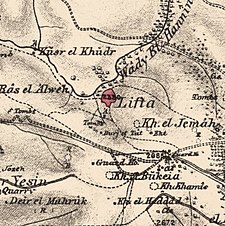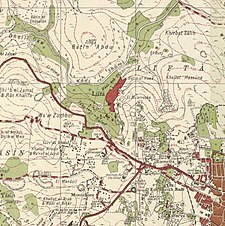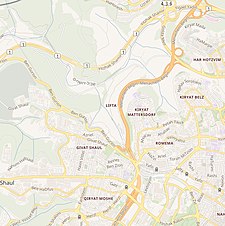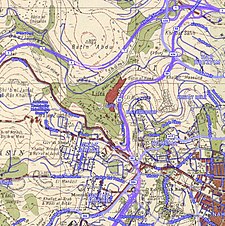Lifta
Lifta
لفتا Lefta | ||
|---|---|---|
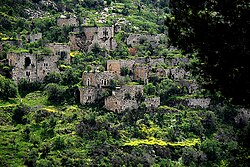 Deserted homes on the hillside | ||
| Etymology: Lifta, personal name[1] | ||
A series of historical maps of the area around Lifta (click the buttons) | ||
Geopolitical entity Mandatory Palestine | | |
| Subdistrict | Jerusalem | |
| Date of depopulation | January 1948[2] | |
| Repopulated dates | 1948–2017 by Jews | |
| Area | ||
| • Total | 8,743 dunams (8.743 km2 or 3.376 sq mi) | |
| Population (1948[3]) | ||
| • Total | 2,958 | |
| Cause(s) of depopulation | Military assault by Yishuv forces | |
| Current Localities | Western suburb of Jerusalem | |


Lifta (
In July 2017, Israel declared Lifta (called Mei Neftoach) as a national nature reserve.[4] It has been referred to as the "Palestinian Pompeii".[5]
History
Antiquity
A perennial spring located in the channel's upper section is believed to be the site where the village first developed. Surrounding this spring, artifacts including a burial cave and pottery shards from the
Archaeological remains dating as far back as Iron Age II have been found in the village.[7][8][9]
Biblical Identification
The site is considered by some to be identical with biblical
Roman and Byzantine periods
The Romans and Byzantines called it Nephtho, and the Crusaders referred to it as Clepsta.[14]
Crusader period
The remains of a court-yard home from the Crusader period remains in the centre of the village.[15]
Ottoman era
In 1596, Lifta was a village in the
In 1834, a battle took place here, during the
In 1863 Victor Guérin described Lifta as being surrounded by gardens of lemon-trees, oranges, figs, pomegranates, alms and apricots.[21] An Ottoman village list of about 1870 indicated 117 houses and a population of 395, though the population count included men, only.[22][23]
The PEF's Survey of Western Palestine in 1883 described it as a village on the side of a steep hill, with a spring and rock-cut tombs to the south.[24]
In 1896 the population of Lifta was estimated to be about 966 persons.[25]
In 1907 the German historian Gustav Rothstein was invited to Lifta by his Arabic language teacher, Elias Nasrallah Haddad. Rothstein wrote a 20-pages article describing the marriage celebrations and religious festivals in Lifta.[26]
British Mandate era

In 1917, Lifta surrendered to the British forces with white flags and, as a symbolic gesture, the keys to the village.[27]
In the 1922 census of Palestine, Lifta had a population 1,451, all Muslims,[28] increasing in the 1931 census (when Lifta was counted with "Shneller's Quarter"), to 1,893; 1,844 Muslims, 35 Jews and 14 Christians, in a total of 410 houses.[29]
During the 1929 Palestine riots, according to one Israeli source, some villagers from Lifta were among gangs that participated in a number of robberies and attacks on nearby Jewish communities.[30][31][32]
In the 1945 statistics the population of Lifta was 2,250; 2,230 Muslims and 20 Christians,[33] and the total land area was 8,743 dunams, according to an official land and population survey.[34] 3,248 dunams were for cereals,[35] while 324 dunams were built-up (urban) land.[36]




Prior to 1948, the village, with a population of some 2,500 people, had orchards, several olive presses, a winepress, in addition to a modern clinic, two coffeehouses, two carpentry shops, barbershops, a butcher, and a mosque.[7][37] A small number of Jews resided in the village, and one former Jewish inhabitants described the relationship her family and the Palestinian majority as 'excellent'.[37]
In the
According to one resident, interviewed in 2021, there were are around 40,000 descendants of the original refugee population, dispersed in East Jerusalem, the West Bank, Jordan and the Palestinian diaspora.[39] Several families still retain their Ottoman period property deeds, attesting to their ownership of parts of Lifta.[39]
State of Israel
After the expulsion of its Palestinian villagers, of Lifta's 410 homes, 60 stone houses, some three stories high, remained, together with its mosque, an olive press, and a tiled pathway to a spring.
Lifta was used for Jewish refugee housing during the war, and following the war the
In the 1980s, Lifta was declared a municipal nature reserve under the auspices of the Israel Nature and Parks Authority.[43][44]
In 1984, one of the abandoned buildings in the village was occupied by the "Lifta gang", a Jewish group plotting the blow up the mosques on the Temple Mount, who were stopped at the gates of the site with 250 pounds of explosives, hand grenades, and other armaments.[45][46]

Following the departure of the Jewish residents, some of the buildings in the village were used for Lifta drug abuse rehabilitation center for adolescents, which was closed in 2014,[47] and from 1971 for the Lifta high school, an open education school, which relocated to German Colony, Jerusalem in 2001.[48]

In 2011, plans were announced to demolish the village and build a luxury development consisting of 212 luxury housing units and a hotel.[49] Former residents brought a legal petition to preserve the village as a historic site.[50] Lifta was the last remaining Arab village that was depopulated to have not been either completely destroyed or re-inhabited.[49] In 2012, the plans to rebuild the village as an upscale neighborhood were rejected by the Jerusalem District Court.[51][37]
By 2011, three books about the Palestinian village history had been published.[52]
In June 2017 the last Jewish residents left the village following a settlement with the government who acknowledged they were not squatters but rather resettled in Lifta by the appropriate authorities.[53] In July 2017 Mei Neftoach was declared a national nature reserve.[4] 55 out of 450 pre-1948 stone houses are still standing.[54][7]
In 2021, the
Archaeology
In 2010, an archaeological survey was conducted at Lifta by Mordechai Heiman on behalf of the Israel Antiquities Authority (IAA).[56]
Arab traditional dress
Lifta was among the wealthiest communities in the Jerusalem area, and the women were known for their fine
]Notable people
See also
- Ali Abunimah
- List of modern names for biblical place names
- Palestinian costumes
- Zochrot
References
- ^ Palmer, 1881, p. 322
- ^ a b Morris, 2004, p. xx, village #363
- ^ Palestinian Central Bureau of Statistics Archived 12 February 2012 at the Wayback Machine also gives village area
- ^ a b According to the law of nature: four new reserves in Israel, Yisrael Hayom, 4 July 2017
- ^ Palestinian ‘Pompeii’ in Jerusalem could face demolition
- ISSN 1565-043X.
- ^ a b c d e Lifta and the Regime of Forgetting: Memory Work and Conservation, Daphna Golan, Zvika Orr, Sami Ershied, Jerusalem Quarterly, 2013, Vol. 54, pp 69-81
- ^ a b Lifta Documentation and Initial Survey (in Hebrew), 2013, Israeli Antiquities Authority]
- ^ Lifta, Archaeological Annex to Development plan, 2003 Israeli Antiquities Authority
- JSTOR 24384308.
- ^ Nephtoah Bible Dictionary
- .
- ^ Conder and Kitchener, 1881, SWP III, p. 18, 47
- ^ Heritage conservation in Israel: Lifta
- ^ Pringle, 1997, p. 66
- ^ Hütteroth and Abdulfattah, 1977, p. 115. Quoted in Khalidi, 1992, p. 301
- ^ Khalidi, 1992, p. 301
- ^ Robinson and Smith, 1841, vol 3, Appendix 2, p. 123
- ^ Robinson and Smith, 1841, vol 2, p. 140
- ^ Robinson and Smith, 1841, vol 2, p. 321
- ^ Guérin, 1868, pp. 252-256
- ^ Socin, 1879, p. 157
- ^ Hartmann, 1883, p. 118, also noted 117 houses
- ^ Conder and Kitchener, 1883, III:18. Quoted in Khalidi, 1992, p. 301
- ^ Schick, 1896, p. 126
- ^ Rothstein, 1914, pp. 102 -123
- ^ Gilbert, 1936, pp. 157-68
- ^ Barron, 1923, Table VII, Sub-district of Jerusalem, p. 14
- ^ Mills, 1932, p. 41
- ^ Halamish, Aviva (1994). ירושלים לדורותיה [Jerusalem through the Ages] (in Hebrew). Open University of Israel. p. 83.
ערבים מכפרי הסביבה - ליפתא, דיר יאסין, עין כרם, מלחה, בית צפאפא, צור באהר וסילואן - ובדווים ממדבר יהודה תקפו בנשק חם את שכונות הספר היהודיות של ירושלים [Arabs from the surrounding villages - Lifta, Dir Yasin, Ein Karem, Makcha, Beit Tsfafa, Tsur Baher and Silwan - and Bedouin from the Yehuda desert attacked the Jewish neighborhoods of Jerusalem with guns]
- ^ Eliav, Binyamin, ed. (1976). היישוב בימי הבית הלאומי [The Settlement in the Days of the National Home] (in Hebrew). Keter Publishing House. p. 38.
לאחר דין ודברים עם השוטרים הותר לקבוצת ערבים מכפר ליפתא לחזור לכפרם דרך רחוב יפו. בהגיעם לרחוב פתחו הליפתאים מיד בשוד החנויות ובפגיעות ביהודים [After discussion with the police, a group of Arabs from Lifta was allowed to return to their village via Yaffa Street. Once there, they right away started looting the shops and attacking Jews]
- ^ Dinur, Ben Tzion, ed. (1964). ספר תולדות ההגנה [The Haganah Book] (in Hebrew). Vol. 2 part 1. Maarachot. p. 316.
וקבוצה אחת בפיקודו של המוכתר מליפתא עלתה על גג והמטירה אש על רחוב יפו [and one group under the command of the Mukhtar of Lifta rained down fire on Yaffa Street]
- ^ Government of Palestine, Department of Statistics, 1945, p. 25
- ^ Government of Palestine, Department of Statistics. Village Statistics, April, 1945. Quoted in Hadawi, 1970, p. 57
- ^ Government of Palestine, Department of Statistics. Village Statistics, April, 1945. Quoted in Hadawi, 1970, p. 103
- ^ Government of Palestine, Department of Statistics. Village Statistics, April, 1945. Quoted in Hadawi, 1970, p. 153
- ^ a b c d Stefanie Glinski, '‘We will return’: the battle to save an ancient Palestinian village from demolition,' The Guardian 29 July 2021
- ^ Morris, 2004, pp. 119-120
- ^ a b c d e Gideon Levy, Alex Levac, 'The Saddest Village in Israel,' Haaretz 23 July 2021:’Each floor of the buildings, fashioned from stone and graced with arches, tells the story of a different period and a different style of construction. Lifta is a rare architectural gem, a monument to what was once here in this country, mute testimony to a way of life that was abruptly cut off. A mosque, olive presses and a flour mill, remains of picturesque balconies, a tiled path leading to the spring, which was one the village’s throbbing heart and whose waters are now in use by yeshiva students and “hilltop youth” in the “between the times” vacation that follows Tisha B’Av.’
- ^ Jerusalem 'Squatter' Discovers That His Home Is Rightfully His, Ha'aretz, 10 February 2012
- ^ The Kenesset discusses eviction of Lifta residents: "the immigrants from Arab countries were called squatters and the Kibutniks - settlers" (in Hebrew), TheMarker, 25 January 2016
- ^ from Settlers to squatters - the classification of residents in absentee property as squatters is injust, Lifta as an example (in Hebrew), Black Labor, Yoni Yochanan, 11 September 2016
- ^ INPA Raises Lifta Security to Prevent Willow Theft, Jerusalem Post, September 19, 2011
- ^ Mei Neftoach (Lifta) (in Hebrew Archived 28 January 2018 at the Wayback Machine, Mapa, encyclopedia entry
- ^ Discourse and Palestine: Power, Text and Context, Annelies Moors, page 133
- ^ Ground Zero: Jerusalem, Holy War, and Collective Insanity, Jerry Kroth, page 131
- ^ Despite the economic improvement, Drug rehabilitation center for adolescents in Lifta to close (in Hebrew), Haaretz, 22 May 2014
- ^ Lifta High School: History Archived 10 July 2017 at the Wayback Machine, Lifta High School
- ^ a b "Israel moves to turn deserted Palestinian village into luxury housing project", Haaretz.com, 21 January 2011.
- ^ Knell, Yolande (30 May 2011). "Legal battle over an abandoned Palestinian village". BBC. Retrieved 30 May 2011.
- ^ Court rules against demolition of empty Lifta homes
- ^ Davis, 2011, p.30 30
- ^ Defeated in Court, Lifta's Last Families to Leave Their Jerusalem-area Homes, Ha'aretz, 22 June 2017
- ^ Esther Zandberg,Unofficial monument to a decisive time in history, Haaretz.com, 25 November 2004; accessed 2 September 2015.
- ^ Surkes, Sue. "Plan shelved to turn historic Arab village at Jerusalem entrance into luxury housing". The Times of Israel. Retrieved 24 June 2023.
- ^ Israel Antiquities Authority, Excavators and Excavations Permit for Year 2010, Survey Permit # A-5974
- ^ Woven legacy, woven language Archived 19 February 2007 at the Wayback Machine, Saudi Aramco World, Volume 42, Number 1.
- ^ Stillman, 1979, pp. 42, 44 (ill.)
- ^ Stillman, 1979, p. 37
- ^ Some sources place the cafe in Lifta (Morris 2004) (Levy21), and some in Romema (Krystall 1999) - which are adjacent to each other
Bibliography
- Avner, Rina (18 January 2008). "Jerusalem, Lifta Final Report" (120). Hadashot Arkheologiyot–Excavations and Surveys in Israel.
{{cite journal}}: Cite journal requires|journal=(help) - Barclay, James Turner (1858). The city of Great King; or, Jerusalem as it was. Philadelphia: J. Challen and sons [etc.] (p. 544)
- Barron, J.B., ed. (1923). Palestine: Report and General Abstracts of the Census of 1922. Government of Palestine.
- Berchem, van, M. (1927). MIFAO 44 Matériaux pour un Corpus Inscriptionum Arabicarum Part 2 Syrie du Sud T.2 Jérusalem Haram. Cairo: Impr. de l'Institut français d'archéologie orientale. (no. 293, pp. 436−437)
- Berchem, van, M. (1920). MIFAO 45.1 Matériaux pour un Corpus Inscriptionum Arabicarum Part 2 Syrie du Sud T.3 Jérusalem Index général. Cairo: Impr. de l'Institut français d'archéologie orientale. (plate LVIII)
- Conder, C.R.; Kitchener, H.H. (1883). The Survey of Western Palestine: Memoirs of the Topography, Orography, Hydrography, and Archaeology. Vol. 3. London: Committee of the Palestine Exploration Fund.
- Dagan, Yehuda; Barda, Leticia (26 December 2010). "Jerusalem, Lifta Survey Final Report" (122). Hadashot Arkheologiyot – Excavations and Surveys in Israel.
{{cite journal}}: Cite journal requires|journal=(help) - ISBN 0-860549-05-4. (p. 900)
- Gilbert, Major Vivian (1936): The Romance of the last Crusade, London, UK
- Government of Palestine, Department of Statistics (1945). Village Statistics, April, 1945.
- Guérin, V. (1868). Description Géographique Historique et Archéologique de la Palestine (in French). Vol. 1: Judee, pt. 1. Paris: L'Imprimerie Nationale.
- Hadawi, S. (1970). Village Statistics of 1945: A Classification of Land and Area ownership in Palestine. Palestine Liberation Organization Research Center.
- Haiman, Mordechai (19 September 2011). "Jerusalem, Lifta Final Report" (123). Hadashot Arkheologiyot – Excavations and Surveys in Israel.
{{cite journal}}: Cite journal requires|journal=(help) - Hartmann, M. (1883). "Die Ortschaftenliste des Liwa Jerusalem in dem türkischen Staatskalender für Syrien auf das Jahr 1288 der Flucht (1871)". Zeitschrift des Deutschen Palästina-Vereins. 6: 102–149.
- Hütteroth, Wolf-Dieter; Abdulfattah, Kamal (1977). Historical Geography of Palestine, Transjordan and Southern Syria in the Late 16th Century. Erlanger Geographische Arbeiten, Sonderband 5. Erlangen, Germany: Vorstand der Fränkischen Geographischen Gesellschaft. ISBN 3-920405-41-2.
- ISBN 0-88728-224-5.
- Mills, E., ed. (1932). Census of Palestine 1931. Population of Villages, Towns and Administrative Areas. Jerusalem: Government of Palestine.
- ISBN 978-0-521-00967-6.
- Palmer, E.H. (1881). The Survey of Western Palestine: Arabic and English Name Lists Collected During the Survey by Lieutenants Conder and Kitchener, R.E. Transliterated and Explained by E.H. Palmer. Committee of the Palestine Exploration Fund.
- ISBN 0521460107.
- Robinson, E.; Smith, E. (1841). Biblical Researches in Palestine, Mount Sinai and Arabia Petraea: A Journal of Travels in the year 1838. Vol. 2. Boston: Crocker & Brewster.
- Robinson, E.; Smith, E. (1841). Biblical Researches in Palestine, Mount Sinai and Arabia Petraea: A Journal of Travels in the year 1838. Vol. 3. Boston: Crocker & Brewster.
- Rothstein, Gustav (1914). "Moslemische Hochzeitsgebrauche in Lifta bei Jerusalem". Palestine Journal (in German and Arabic). VI: 102 -123, 124-135.
- Schick, C. (1896). "Zur Einwohnerzahl des Bezirks Jerusalem". Zeitschrift des Deutschen Palästina-Vereins. 19: 120–127.
- Schölch, Alexander (1993). Palestine in Transformation, 1856-1882: Studies in Social, Economic, and Political Development. ISBN 978-0-88728-234-8.
- Socin, A. (1879). "Alphabetisches Verzeichniss von Ortschaften des Paschalik Jerusalem". Zeitschrift des Deutschen Palästina-Vereins. 2: 135–163.
- Stillman, Yedida Kalfon (1979). Palestinian Costume and Jewelry. Albuquerque: 's) collection of Palestinian clothing and jewellery.)
- Tobler, T. (1854). Dr. Titus Toblers zwei Bucher Topographie von Jerusalem und seinen Umgebungen (in German). Vol. 2. Berlin: G. Reimer. (pp. 758-60; cited in Pringle, 1997, p. 66)
- Zelinger, Yehiel (18 September 2011). "Jerusalem, Lifta, Final Report" (123). Hadashot Arkheologiyot – Excavations and Surveys in Israel.
{{cite journal}}: Cite journal requires|journal=(help)
External links
- Welcome to Lifta, palestineremembered.com; accessed 2 September 2015.
- Lifta, Zochrot
- [1], The Ruins of Lifta (2016)
- Israel Antiquities Authority, Jerusalem, Lifta, Survey (2010)
- Survey of Western Palestine, Map 17: IAA, Wikimedia commons
- Lifta in Antiquity Archaeological Survey of Israel
- F.A.S.T.-Lifta Preservation Joint project on the reconstruction of memory and the preservation of Lifta, archive.org, 14 May 2006.
- Lifta photos by Dr Moslih Kanaaneh, jalili48.com; accessed 2 September 2015.
- Lifta, by Rami Nashashibi (1996), Center for Research and Documentation of Palestinian Society.
- Lifta, zochrot.org
- Return to Lifta, 13 May 2006, zochrot.org
- Lifta Society website, liftasociety.org
- Lifta website, schulen.eduhi.at
- 3D models of different houses in Lifta, sketchfab.com; accessed 2 September 2015.

